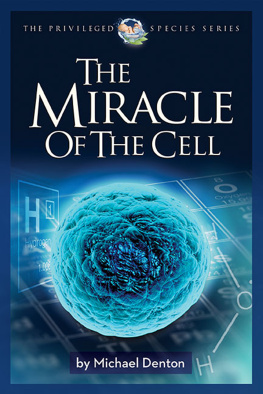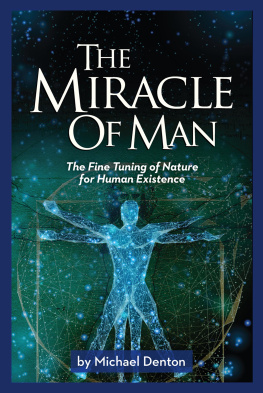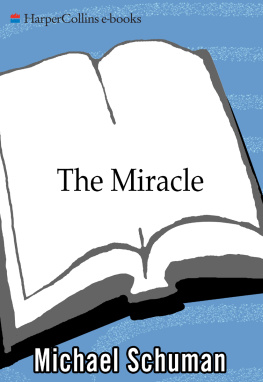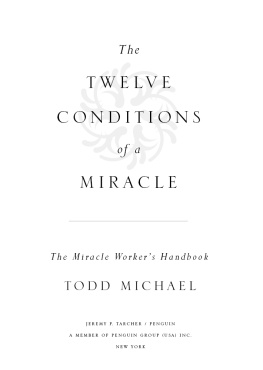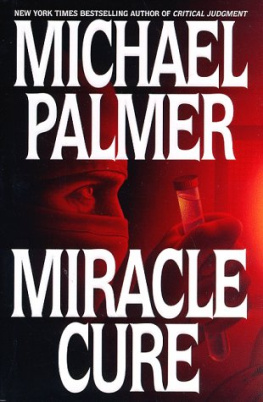Michael Denton - The Miracle of the Cell
Here you can read online Michael Denton - The Miracle of the Cell full text of the book (entire story) in english for free. Download pdf and epub, get meaning, cover and reviews about this ebook. publisher: Discovery Institute Press, genre: Religion. Description of the work, (preface) as well as reviews are available. Best literature library LitArk.com created for fans of good reading and offers a wide selection of genres:
Romance novel
Science fiction
Adventure
Detective
Science
History
Home and family
Prose
Art
Politics
Computer
Non-fiction
Religion
Business
Children
Humor
Choose a favorite category and find really read worthwhile books. Enjoy immersion in the world of imagination, feel the emotions of the characters or learn something new for yourself, make an fascinating discovery.
- Book:The Miracle of the Cell
- Author:
- Publisher:Discovery Institute Press
- Genre:
- Rating:3 / 5
- Favourites:Add to favourites
- Your mark:
- 60
- 1
- 2
- 3
- 4
- 5
The Miracle of the Cell: summary, description and annotation
We offer to read an annotation, description, summary or preface (depends on what the author of the book "The Miracle of the Cell" wrote himself). If you haven't found the necessary information about the book — write in the comments, we will try to find it.
The Miracle of the Cell — read online for free the complete book (whole text) full work
Below is the text of the book, divided by pages. System saving the place of the last page read, allows you to conveniently read the book "The Miracle of the Cell" online for free, without having to search again every time where you left off. Put a bookmark, and you can go to the page where you finished reading at any time.
Font size:
Interval:
Bookmark:
ACKNOWLEDGMENTS
I AM INDEBTED TO SEVERAL KEY TEXTS FROM WHICH MUCH OF THE evidence I cite was taken. These include J. J. R. Frasto da Silva, The Biological Chemistry of the Elements (1991); Wolfgang Kaim, Brigitte Schwederski, and Axel Klein, Bioinorganic Chemistry , 2nd ed. (2013); Robert R. Crichton, Biological Inorganic Chemistry, 2nd ed. (2012); Rob Phillips et al., Physical Biology of the Cell , 2nd ed. (2013); Peter Atkins, The Periodic Kingdom (1996); Nick Lane, The Vital Question (2015); and Bruce Alberts et al., Molecular Biology of the Cell , 4th ed. (2002).
And as always, I am indebted to Lawrence Hendersons great classic The Fitness of the Environment (1913).
I also am indebted to Iain Johnston and Tyler Hampton for careful criticisms and readings of earlier drafts of the monograph, for the valuable input of science reviewers later in the process, and for the staff at the Discovery Institute for their considerable editing efforts, especially Jonathan Witt and Rachel Adams.
1. THE AMAZING CELL
To see a world in a grain of sand
And a heaven in a wild flower,
Hold infinity in the palm of your hand,
And eternity in an hour.
W ILLIAM B LAKE (1803), A UGURIES OF I NNOCENCE
C ELLS ARE AMAZING . E VEN TO A NON-BIOLOGIST, THEY CONVEY THE impression of being very special objects with extraordinary capabilities. No one who has observed a leucocyte (a white blood cell) purposefullyone might even say single-mindedlychasing after a bacterium in a blood smear would disagree. To see this in action, watch the brief online video by What one witnesses there seems to transcend all our intuitions: A tiny speck of matter, invisible to the naked eye, so small that one hundred of them could be lined up across the top of a pin, is seemingly endowed with intention and agency. Its like watching a house cat chasing a mouse, or a cheetah chasing a gazelle on the African savanna, or indeed a man chasing down a kudu in the Kalahari.
It does not lessen the amazement to conclude that this ability must arise somehow from the atomic complexity that lies within this wondrous speck of matter. For the complexity in which this behavior is instantiated is also far beyond ordinary experience. A cell consists of trillions of atoms, representing the complexity of a jumbo jet and more, packed into a space less than a millionth of the volume of a typical grain of sand. But unlike any jumbo jet, unlike any nano-tech, or indeed unlike even the most advanced human technology of any kind, this wondrous entity can replicate itself. Here is an infinity machine with seemingly magical powers.
In terms of compressed complexity, cells are without peer in the material world, actualized or imagined. And there is likely far more complexity still to uncover. Fitness of the Environment , the cell was a black box, its actual molecular complexity a mysterious unknown. Only as the veil began to lift with the mid-century molecular biological revolution did science begin to glimpse the sophistication of these extraordinary pieces of matter. Subsequently, every decade of research has revealed further depths of complexity. The discovery of ever more intricate structures and systems with each increase in knowledgeincluding vastly complex DNA topologies and a vast and growing inventory of mini-RNA regulator moleculestells us there is probably much more to uncover. What we glimpse now may be only a tiny fraction of what remains to be discovered.
As
There is much more to discover about the cell, but even from our current limited knowledge of its depths it is clear that this tiny unit of compact, adaptive sophistication constitutes something like a third infinity . Where the cosmos feels infinitely large and the atomic realm infinitely small, the cell feels infinitely complex .
But cells are not just complex beyond any sensible measure and beyond any other conceivable material form. They appear in so many ways supremely fit to fulfill their role as the basic unit of biological life. One element of this fitness is manifest in their incomparable diversity of form. Contrast a neuron with a red blood cell, a skin cell with a liver cell, an amoeboid leucocyte with a muscle cell. Each of these different forms is found in the human body, and many more. Or consider the diversity of ciliate protozoans. From the trumpet-like Stentor to the dashing Paramecium , the universe of ciliate form is absurdly diverse. Or take the radiolarians (see Figure ). Even within this small related group of organisms, the diversity of cell forms is stunning. And yet every member of this fantastic zoo of radiolarian forms is built on exactly the same canonical design.
The unique fitness of the cell to serve as the fundamental unit of life is also manifest in its amazing abilities and the diversity of functions it performs. Even the tiny E. coli , a cylinder-shaped bacterium in the human gut, has spectacular capabilities.
Cells also move in many diverse ways. E. coli travel by the propeller-like action of the bacterial flagellum. Others do so via the beating action of cilia. Some creep and crawl. Some put out pseudopodia and grasp small objects in their immediate vicinity.
Figure 1.1. Radiolarian shells, plate 31 from Ernst Haeckels Kunstformen der Natur , 1904. |
Some cells can survive desiccation for hundreds of years. Cells possess internal clocks and can measure the passage of time.
These remarkable specks of organized matter have constructed every multicellular organism on Earth, including the human body, itself a vast collective of as many as 100 million million cells. Cells compose the human brain, making a million connections a minute for nine months during gestation. Cells build blue whales, butterflies, birds, and the giant sequoias of Yosemite. Cells constituted the dinosaurs and all past life ever born on Earth. And through the activities of some of the simplest of their kind, cells gradually terraformed the planet over the past 3,000 million years, generating oxygen via photosynthesis and releasing its energizing powers for all the higher life forms. They are the universal constructor set of life on Earth. In short, they can do almost anything, adopt almost any shape, and obey any order. They appear, in every sense, perfectly adapted to their assigned task of creating a biosphere replete with multicellular organisms like ourselves.
When we observe the goings-on of protozoans in a drop of pond water or the antics of an amoeboid leucocyte in the human blood stream chasing a bacterium, it is hard to resist the feeling that these microscopic life forms are sentient, autonomous beings. This was the case when we had relatively primitive microscopic technology more than one hundred years ago, and it is all the more so today.
It is not just their hunting strategies (seen in the video of the leucocyte chasing its prey) that resemble the behaviors of higher organisms. Another striking example is the courtship rituals of ciliates, rituals that include pre-conjugal mating dances, reciprocal learning, repeated touching of prospective mates, and even deceit and cheating when communicating reproductive fitness to potential mates.
Jenningss thoughts were recently echoed by biologist
And as Ford continues, We regard amoebas as simple and crude. Yet many types of amoeba construct glassy shells by picking up sand grains from the mud in which they live. The typical Difflugia shell, for example, is shaped like a vase, and has a remarkable symmetry We just dont know how this single-celled organism builds its shell.
Even if cells are not sentient beings, their accomplishments, their complexity, their diversity of structure and function, remain to astound us. The unique powers of cellswhat and their extraordinary fitness to play their unique role as the building blocks of all life on Earth are a wonder apparent to anyone who gives them even a cursory consideration.
Font size:
Interval:
Bookmark:
Similar books «The Miracle of the Cell»
Look at similar books to The Miracle of the Cell. We have selected literature similar in name and meaning in the hope of providing readers with more options to find new, interesting, not yet read works.
Discussion, reviews of the book The Miracle of the Cell and just readers' own opinions. Leave your comments, write what you think about the work, its meaning or the main characters. Specify what exactly you liked and what you didn't like, and why you think so.

